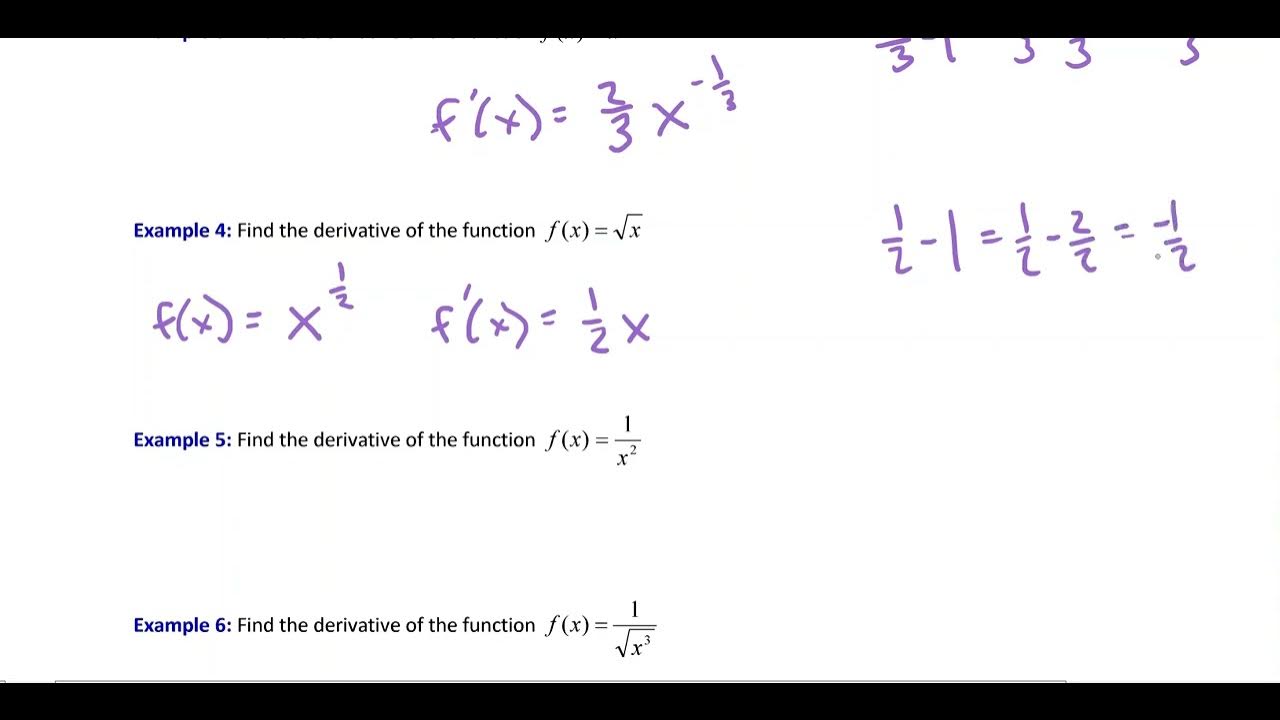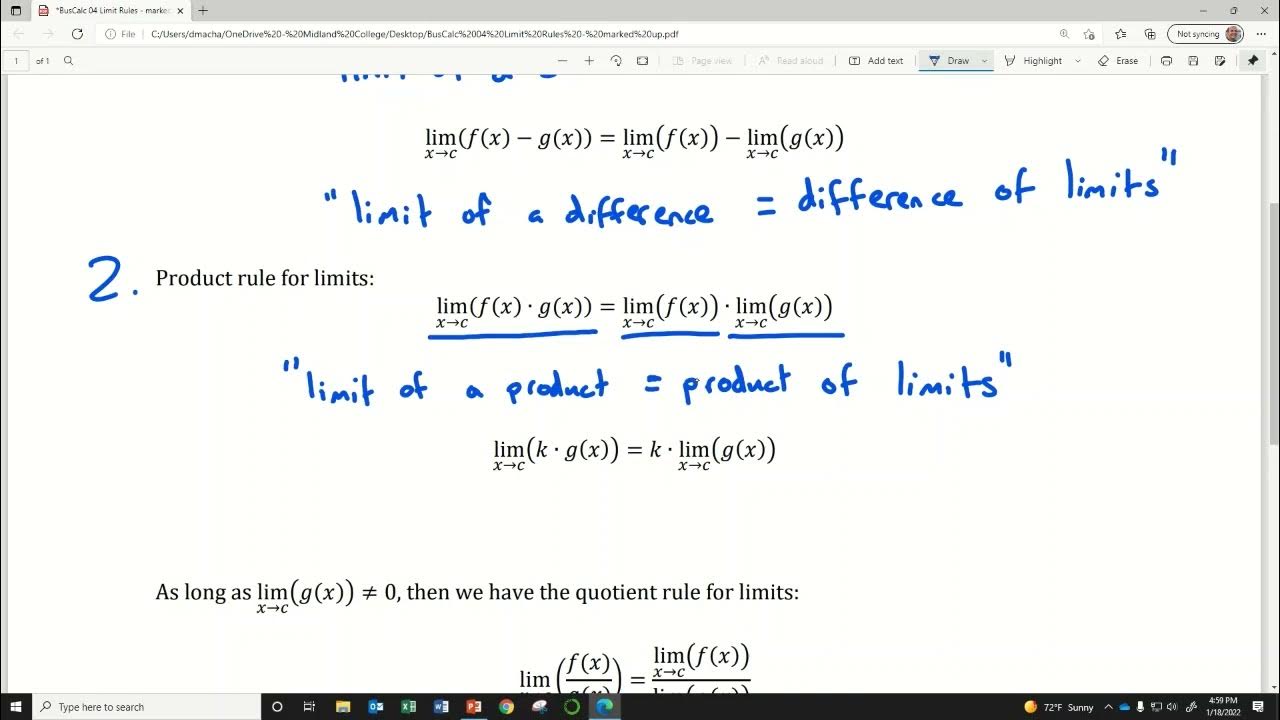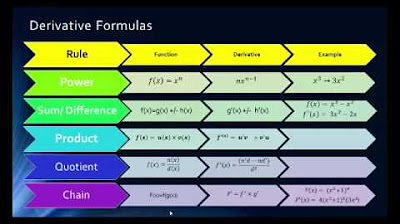The Integral Calculus Rules — Topic 86 of Machine Learning Foundations
TLDRThe video script provides a comprehensive overview of the three fundamental rules for symbolic integration: the power rule, the constant multiple rule, and the sum rule. The power rule is introduced first, explaining how to integrate a function of the form x^n by adding one to the exponent and dividing by the new exponent. It highlights the limitation of not being able to integrate a negative power due to division by zero. The constant multiple rule is then discussed, emphasizing that constants can be factored out of the integral and reintroduced after integration. An example with 9x^2 is used to illustrate this rule. Lastly, the sum rule is presented, which allows for the separate integration of terms within an expression. The script concludes with an example integrating x^4 + 9x^2, demonstrating the application of the sum rule. The video promises further exercises for practice in the next installment.
Takeaways
- 📚 The video discusses three key rules for symbolic integration: the power rule, the constant multiple rule, and the sum rule.
- 🔢 The power rule for integration states that the integral of x to the power of n is x to the power of (n+1) divided by (n+1), provided n is not negative one to avoid division by zero.
- 🚫 A limitation of the power rule is that you cannot integrate a term with a negative exponent because it would result in division by zero.
- 🔄 The constant term 'C' is added after integration to account for any constant that might have been lost during differentiation.
- 📈 The constant multiple rule allows you to separate a constant from the function being integrated, integrate the function, and then reintroduce the constant.
- 🧮 An example of the constant multiple rule is integrating 9x^2, which becomes 9 times the integral of x^2, resulting in 3x^3 + C after integration.
- 🔁 The sum rule in integration is similar to the sum rule in differentiation, allowing you to integrate each term of a sum separately and then combine the results.
- 🌐 An example of the sum rule is integrating x^4 + 9x^2, which is done by integrating x^4 to get x^5/5 and 9x^2 to get 3x^3, with the constant C added for the indefinite integral.
- ⚙️ The video script provides a clear explanation of how each rule works and how they are applied in the process of integration.
- 📝 The script emphasizes the importance of understanding the inverse relationship between differentiation and integration rules.
- 📚 The video concludes with a mention of upcoming exercises for viewers to practice integrating equations on their own.
Q & A
What are the three most important rules for integrating an equation symbolically?
-The three most important rules for integrating an equation symbolically are the power rule, the constant multiple rule, and the sum rule.
How does the power rule for integration differ from the power rule for differentiation?
-The power rule for differentiation involves raising the power of x by one less than the original power and multiplying by the original power, whereas the power rule for integration involves raising the power of x by one more than the original power and dividing by the new power.
Why can't we integrate a function that's to the power of negative one?
-We can't integrate a function that's to the power of negative one because it would result in a division by zero, which is mathematically impossible.
Why do we add a constant term, denoted by 'C', when integrating?
-We add a constant term when integrating because differentiation can lose the constant term from the original function. The constant term 'C' accounts for the possibility that there may have been a constant present before differentiation.
How does the constant multiple rule apply when integrating?
-The constant multiple rule states that when integrating a function with a constant multiplier, you can ignore the constant during integration, perform the integration on the remaining function, and then multiply the result by the constant afterward.
What is the sum rule in integration, and how does it compare to the sum rule in differentiation?
-The sum rule in integration allows you to integrate separate terms of a function independently of each other, just as you can differentiate terms separately. It is analogous to the sum rule in differentiation.
What happens to a constant term during the process of differentiation?
-During differentiation, a constant term becomes zero because the derivative of a constant is zero.
How does the integration of x to the power of four result, according to the power rule?
-The integration of x to the power of four, according to the power rule, results in x to the power of five divided by 5, plus the constant term C.
What is the integral of 9x squared using the constant multiple rule and the power rule?
-The integral of 9x squared is 3x cubed plus the constant term C, after applying the constant multiple rule by factoring out the 9 and then applying the power rule to x squared.
What is the sum rule in the context of integration, and how is it applied?
-The sum rule in integration states that if you have multiple terms in an integral, you can integrate each term separately and then sum the results. It is applied by breaking down the integral into parts and integrating each part individually before combining them.
Why are definite integrals different from indefinite integrals in terms of handling the constant term?
-Definite integrals have a way of eliminating the constant term because they involve integrating over a specific interval and the constant term cancels out. In contrast, indefinite integrals do not have interval bounds and thus retain the constant term, making them indefinite.
What is the limitation of the power rule for integration when it comes to negative exponents?
-The limitation of the power rule for integration when it comes to negative exponents is that it cannot be applied because it would result in a division by zero, which is undefined.
Outlines
📚 Introduction to Symbolic Integration Rules
This paragraph introduces the three fundamental rules for symbolic integration: the power rule, the constant multiple rule, and the sum rule. It emphasizes the inverse relationship between these integration rules and their corresponding differentiation rules. The power rule for integration is explained with an example, showing how to integrate x to the power of n as x to the power of (n+1) divided by (n+1), and noting the limitation when dealing with negative powers. The importance of including a constant term (C) in the integration process is highlighted, as it accounts for constants that may have been lost during differentiation. An example of integrating x to the power of four is provided, resulting in x to the power of five divided by 5 plus C. The constant multiple rule is then introduced, with an example of integrating 9x squared, which simplifies to 3x cubed plus C after applying the rule. Lastly, the sum rule is briefly mentioned, indicating that terms within an integral can be integrated separately.
🔢 Applying Integration Rules with Examples
The second paragraph delves into applying the previously mentioned integration rules with numerical examples. It begins by reiterating the process of integrating x to the power of 4, which results in x to the power of 5 divided by 5, including the constant term. The paragraph then moves on to integrate the sum of two terms, x to the power of 4 and 9x squared. For each term, the respective integration rules are applied separately. The first term, x to the power of 4, is integrated to x to the power of 5 over 5, and the second term, 9x squared, is integrated to 3x cubed. The paragraph concludes by reminding viewers to account for the constant term in indefinite integrals, emphasizing the importance of practice through upcoming exercises to solidify understanding of these integration techniques.
Mindmap
Keywords
💡Power Rule
💡Constant Multiple Rule
💡Sum Rule
💡Integration
💡Differentiation
💡Constant of Integration
💡Indefinite Integral
💡Definite Integrals
💡Symbolic Integration
💡Machine Learning Foundation Series
💡Limitations
Highlights
The video details three important rules for integrating an equation symbolically: the power rule, the constant multiple rule, and the sum rule.
The power rule for integration states that when integrating x to the power of n, the result is x to the power of n plus 1 divided by n plus 1.
The power rule for differentiation does the opposite, turning x to the power of n into x to the power of n minus 1.
A limitation of the power rule is that you cannot integrate something to the power of negative one, as it would result in dividing by zero.
When integrating, you must add a constant term (C) to account for any constant that may have been lost during differentiation.
The constant multiple rule allows you to ignore the constant while integrating the function, then bring it back after integration.
An example of the constant multiple rule is integrating 9x squared, which becomes 9 times the integral of x squared.
The sum rule states that you can integrate separate terms in an equation separately, just like you can differentiate them separately.
An example of the sum rule is integrating x to the power of 4 plus 9x squared, which can be done by integrating each term individually.
When dealing with indefinite integrals, the constant term (C) is always included, but it can be eliminated with definite integrals.
The video provides step-by-step examples to illustrate how to apply the power rule, constant multiple rule, and sum rule in practice.
The power rule for integration is derived from the corresponding rule for differentiation, which performs the opposite operation.
The constant multiple rule is similar to its counterpart in differentiation, allowing you to treat the constant separately during integration.
The sum rule is analogous to the rule for differentiating separate terms, allowing you to integrate them independently.
The video emphasizes the importance of including the constant term (C) when integrating to account for constants lost during differentiation.
The next video will feature exercises for practicing integrating equations using these rules.
The video aims to make the integration rules clear and easy to understand through concise explanations and relevant examples.
Transcripts
5.0 / 5 (0 votes)
Thanks for rating:





